"Gelato!" May 6, 2010 - Volume 2 - Issue 09
|
|
|
|
|
|
Get Ready for Summer!
|
Every
season is a good season for ice cream and its frozen cousins, but
anticipating the entire summer ahead creates added inspiration. We
shift our kitchen around for the seasons like some rearrange their
clothes closets. The slow cooker slips deeper into the cupboard, and
the blender and ice cream maker slide forward. This spring we're
experimenting with gelato - the intense, Italian-inspired version of
ice cream that raises frozen pleasures to a new level. We like homemade
gelato, ice cream, and other freezes for all of the obvious, cold,
refreshing reasons, but also for its fresh ingredients, no
preservatives, no foreign substances, no guar gum, carageenan, mono-
and di-glycerides, etc., just great personalized taste.
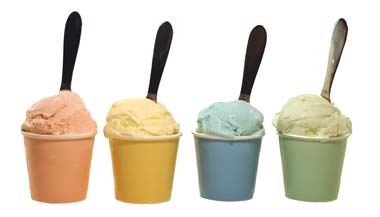
In this issue,
we'll explore summer's sweet frozen options, and equip you with how to
make and serve your own favorites. We finish with a twist on three
classics, vanilla gelato, chocolate sorbet, and strawberry gelato. Get your spoons ready!
|
Spring Special
| 
|
|
|
|
Frozen Cousins
|
Many
ice cream terms get used interchangeably and differently depending
where you are in the world, but there are distinct differences among
frozen treats. We'll begin by answering some key basic questions:

Two Styles of Ice Cream and Gelato: There are two basic styles of ice cream and gelato: custard-based or
Philadelphia-style. Custard styles have egg yolks in the base,
Philadelphia-styles do not. Mixtures with eggs must be cooked to a
temperature of 185ºF for food safety purposes, and then thoroughly
chilled prior to churning. Egg yolks serve to stabilize the milk and
cream mixture with their high protein content, and the natural lecithin
acts as a butterfat emulsifier. Philadelphia-style gelati and ice
creams skip the egg yolks and reach the churning step faster with its
own style of richness.
|
Freezing Treats
|
Freezing
your choice of cold relief is easier than ever! Not long ago, homemade
ice cream involved tons of ice, rock salt, and a sore arm from cranking
the handle. No more! By far the easiest way to make homemade frozen
treats is with a double-insulated, pre-frozen cylinder - a freezer bowl
-- that fits into a holder for churning and produces fresh, frozen
goodness in 20-30 minutes.
 What is churning and why must it be done? What is churning and why must it be done?
Churning accomplishes three things during the gelato and ice cream freezing process:
(1) the chilled mixture becomes frozen,
(2) air is incorporated into the mix, and
(3) a smooth consistency of tiny ice crystals is formed.
By
consistently moving the mixture around the freezer bowl, these three
essential things are accomplished transforming sweet liquid into the
best ever food invention. Air is essential for texture and
scoop-ability. Without air, the mixture would be rock hard. The
churning process forms miniscule ice crystals that create a smooth
texture and an optimal mouth feel.
After Churning
After the ice
cream maker has done its work, the once liquid mixture will be frozen
and ready to eat. However, if you prefer a harder ice cream, remove the
frozen treat from the freezer bowl, place in another container, cover
well, and place in your refrigerator's freezer until ready to eat.
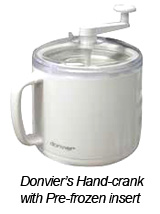 How to Choose the Right Freezer for You How to Choose the Right Freezer for You
There
are many styles of ice cream makers available. Your choice will be
based on preferences and desired ice cream habits. Think about
performance, size, and, most importantly, ease and convenience!
Donvier's Hand-Powered Ice Cream Maker - This simple unit uses a pre-frozen freezer bowl and paddle connected to a simple hand-powered crank.  During cranking, a slow, smooth motion will freeze one quart of your favorite frozen recipe in about 20-30 minutes. During cranking, a slow, smooth motion will freeze one quart of your favorite frozen recipe in about 20-30 minutes.
Cuisinart's Automatic ICE-20 Series 1.5 Qt. - This machine is a great entry point for homemade ice cream, gelato
and all kinds of frozen treats. This ice cream maker also uses a
pre-frozen freezer bowl. When ready, the rotating scraper/blade is
powered by a motor that effortlessly moves the mixture within the
freezer bowl producing a smooth consistency. The ice cream maker's top
sports a wide pouring spout that makes adding the mix and any mix-ins
easy.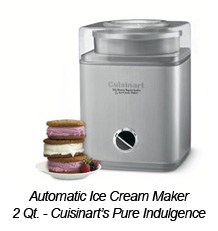
Cuisinart's Pure IndulgenceTM 2 Qt. -
This machine offers a larger 2-quart capacity in a brushed metal
housing. Ice cream is ready in 20-30 minutes. A pre-frozen insert is
also used to bring icy coldness to the process. A heavy duty motor
smoothly churns the mixture making for a smooth, even result. 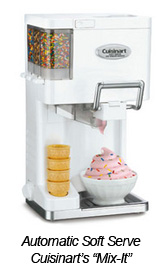 The lid has a wide spout for accommodating all mixes and mix-ins. The lid has a wide spout for accommodating all mixes and mix-ins.
Cuisinart's Mix It InTM Soft Serve Ice Cream Maker -
This product effectively places an ice cream shoppe in your kitchen.
Also using a pre-frozen freezer bowl, the mix is churned with the help
of a motor. The unit has three mix-in compartments that hold and add
your favorite additions. A dispensing mechanism serves the plain or
embellished ice cream into cones or dishes.
SupremeTM Commercial Quality Ice Cream Maker -
This machine has a built-in compressor-freezer that eliminates the need
for a pre-frozen insert. Acting as a mini-freezer, the machine cools
and freezes batch after batch of ice cream, gelato, or sorbet. The
strong motor moves the paddle within the freezing chamber. This unit
doubles as a great frozen drink maker.
|
Smart Freezing Tips
|
Tip #1:
For best results, chill the liquid mixture well prior to freezing. When
chilled to refrigerator temperature, 39ºF, it will have less "distance"
to go to a frozen state beginning at around 32ºF and ending at a
storing temperature close to 0ºF.
Tip #2:
Match the recipe quantity with the size of your freezer bowl. The
mixture will expand in size as air is incorporated and ice crystals are
formed. Generally, fill the freezer bowl only two-thirds full. 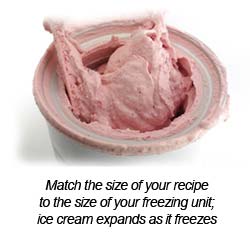 This will
allow for expansion space and churning room. This will
allow for expansion space and churning room.
Tip #3: Frozen foods can dull taste buds. Make sure that any fruits used are
very ripe and flavorful. A liquid mixture may taste too strong, but
will freeze nicely with great flavor.
Tip #4: Allow the freezer bowl to be thoroughly chilled prior to churning. A
typical 1-1.5 qt. bowl will take between 6 - 22 hours to become
completely frozen depending on your freezer. Gently shake the bowl to
test its frozen-ness; if you hear liquid sloshing about, more chilling
time is required.
Tip #5: If your gelato or ice cream uses alcoholic liqueurs, add at the very
end of the churning process. Alcohol lowers freezing temperatures and
may interfere with proper freezing if added earlier.
Tip #6: Buy an extra freezer bowl. Having two freezer bowls is a dream come
true! Two batches can be made quickly in sequence, or different flavors
presented at the same time.
Tip #7: Store your frozen ice cream in a separate container than the freezer
bowl. The ice cream will continue to freeze and become harder. Scooping
hardened ice cream may damage the freezer bowl. Also, ice cream will
taste fresher and not take on freezer odors if stored in an airtight
container.
|
Q & A's
|
 Q: My homemade ice cream becomes very hard after a day or two in the freezer. What's wrong? Q: My homemade ice cream becomes very hard after a day or two in the freezer. What's wrong?
A: Homemade ice cream has less air incorporated into it than commercial
versions; this makes it harder when thoroughly frozen. Softer treats
can be had in several ways: (1) Add more sugar to the mixture; this
inhibits hard freezing, (2) Store at a warmer temperature, (3) Allow
the container to stand covered on the counter for a few minutes before
scooping, or (4) Microwave the container on half power for 10 seconds.
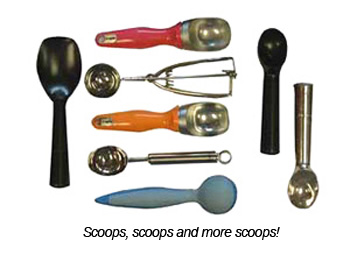 Q: What's the best way to scoop ice
cream? Q: What's the best way to scoop ice
cream?
A: Frozen treats
can require some arm muscle to get from container to dish! Regular
flatware spoons will easily bend under the frozen pressure. A great
scoop makes life easier! Choose from many styles of scoops designed to
collect and release any frozen concoction. You'll find insulated scoops,
scoops with a releasing lever, and many other styles. Check the handle
of your scoop - is it comfortable? Long enough for applying some
leverage? We'll be glad to show you our favorites.
Q: My ice cream and even my ice have an off flavor. What causes it and how can it be prevented?
A: Despite the cold of a freezer, condensation and oxidation can occur on
the surfaces of all frozen foods including plain ice. Both these
processes can result in tastes and odors resident in the freezer (and
the refrigerator that may share air with the freezer), landing and
crystallizing on the food's surface. Tightly wrap all foods to minimize
air exposure. For ice cream, a layer of plastic wrap placed directly on
its surface will help reduce frozen condensation and subsequent freezer
odors and tastes.
Q: The
chunks of fruit in my ice cream become like hard rocks when frozen and
eaten. How can I make them softer and make a better ice cream texture?
A: When
adding fresh fruit to your frozen concoction, dice or mince to a small
size, then sprinkle the pieces with sugar allowing them to stand for
several minutes. The sugar will draw out excess water allowing the
fruit pieces to remain softer once completely frozen. Add the macerated
fruit to the ice cream mixture only in the final minutes of freezing. |
Cookbook Review
|
Making Artisan Gelato
by Torrance Kopfer. Photography by Madeline Polss. Published by Quarry
Books, a member of Quayside Publishing Group, Beverly, MA. Copyright
2009.
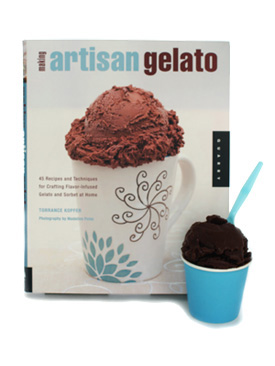 Whether
a novice, first time, ice cream maker, or a practiced churner, this
cookbook with its stunning photography provides basic instruction and
advanced inspiration to take you to the next level. The first part of
the book is instructional. Chef Kopfer guides us through the two basics
types frozen bases - custard (egg) bases which must be cooked and
chilled and Philadelphia-style, non-cooked bases. (This book gets extra
bonus points for including ingredient weights along with volume
measurements). The focus is on making great gelato, but sorbets and
granitas are equally worthy inclusions. Kopfer articulates the key
points that yield desired success at the end of the process. With this
expert guidance, recipes are offered that range from basic to exotic
with flavor and flair. We started by sampling the basics -- vanilla,
chocolate, and strawberry - with the recipes below. Those now mastered,
we have a few enticing concoctions on our list of flavors to try next:
Pistachio Gelato, Blueberry Lavender Gelato, Candied Ginger Gelato,
Pink Grapefruit, and Tarragon Sorbet. Mmmm . . . . Whether
a novice, first time, ice cream maker, or a practiced churner, this
cookbook with its stunning photography provides basic instruction and
advanced inspiration to take you to the next level. The first part of
the book is instructional. Chef Kopfer guides us through the two basics
types frozen bases - custard (egg) bases which must be cooked and
chilled and Philadelphia-style, non-cooked bases. (This book gets extra
bonus points for including ingredient weights along with volume
measurements). The focus is on making great gelato, but sorbets and
granitas are equally worthy inclusions. Kopfer articulates the key
points that yield desired success at the end of the process. With this
expert guidance, recipes are offered that range from basic to exotic
with flavor and flair. We started by sampling the basics -- vanilla,
chocolate, and strawberry - with the recipes below. Those now mastered,
we have a few enticing concoctions on our list of flavors to try next:
Pistachio Gelato, Blueberry Lavender Gelato, Candied Ginger Gelato,
Pink Grapefruit, and Tarragon Sorbet. Mmmm . . . .
|
Gelato and Sorbet Recipes
|
Recipes excerpted from Making Artisan Gelato
by Torrance Kopfer. Published by Quarry Books, a member of Quayside
Publishing Group, Beverly, MA. Copyright 2009. Reprinted with
permission of the publisher. All rights reserved.
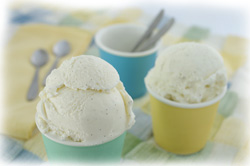 Madagascar Bourbon Vanilla Gelato Madagascar Bourbon Vanilla Gelato
View and Print
Vanilla
is a perfect place to start mastering home-crafted freezes. This recipe
is in the Philadelphia-style tradition of no eggs, no custard-making
step. Rather, the richness comes from a slightly greater reliance on
cream. The vanilla flavor in this version comes from a fragrant vanilla
bean pod steeped in milk. The finished vanilla flavor was nicely
balanced with the sweetened cream.
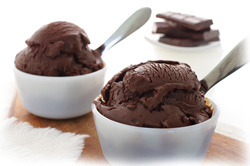 Chocolate Sorbet Chocolate Sorbet
View and Print
Like
all sorbets, this deep chocolate version is based on a simple sugar and
water mix. A double depth of chocolate is added with cocoa and melted
dark chocolate - it's like a primo
fudgsicle. The mixture freezes easily and forms a perfectly smooth
texture. The result is a satisfying experience that brings new meaning
to the oft-used chocolate phrase, "melts in your mouth...."
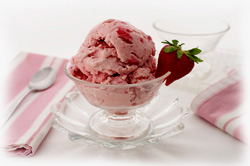 Strawberry Gelato Strawberry Gelato
View and Print
What
better way to celebrate the beginning of summer than with the very best
frozen strawberry concoction you can imagine. Building on the
flavor-burst of ripe, local berries, this classic pairing with cream
generates a seasonal favorite not too be missed. This recipe
demonstrates a cooked custard base - a good technique to master and
become comfortable with in the frozen treat world.
|
|
Enjoy a summer's worth of homemade frozen treats!
|
|
Lorraine, Katie, and all of the Staff at Beyond Pots and Pans
|
|
|
|
|